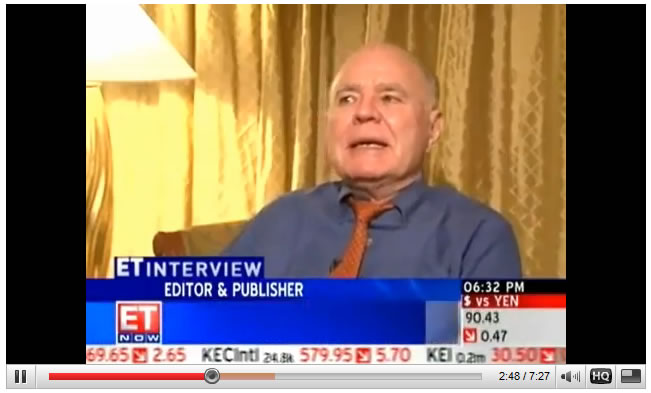Will Dr. Marc Faber Be Wrong Again This Autumn?
Originally - 23rd Sept 2009 Apologies to my old friend and colleague Dr. Marc Faber but not all his calls are right. Last autumn he recommended buying US stocks just as they started a plunge that ended with the S&P at 666, the devil’s bottom in March. Today listeners to Bloomberg heard a repeat of the same optimism from the editor and publisher of the Gloom, Boom & Doom Report. His logic is a repeat of last autumn. ‘Where there is inflation in the system as defined by money supply growth and credit growth, you have currency weakness, he said. ‘Stocks can easily go higher. If you print the money, they can go anywhere.’ Nice theory but wrong It is a nice theory but then it did not prove correct last year, and I checked in the GBD report for the reference and there it is in print. Dr. Faber seems obsessed by Ben Bernanke as a ‘money printer at the Fed’ and foresees hyperinflation like Weimar Germany where stocks soared ever higher as the economy collapsed. In the Gloom, Boom & Doom Report last September he said stocks were the best investment for US investors just as the market headed for a crash comparable in many eyes to 1929. The rally since March has also followed the course of the rally seen in 1930 both in percentage strength and duration. And there has not been a single occasion in 100 years that such a rally has not ended with a dramatic correction. Is it really so different this time? Yes, the US government has vigorously pumped money into the economy, and the Chinese have done even better. But is all this state spending going to compensate for the collapse of trade, consumer spending and the global private sector including the banks? It is a hole of 1930’s dimensions, actually bigger, and real damage has been done to the real economy. Now tell me why stocks should be valued so highly in these circumstances that are a disaster for business profits now and in the future? Bubble trouble again This is once again such an obvious bubble waiting to pop. And yes that is what this website said a year ago. The disconnection between the financial markets and the real world has never been bigger, not even last autumn. Surely there is also a limit to how much money that can be injected into the system before it begins to backfire in terms of devaluation and inflation? And with interest rates virtually at zero there is no further room to lower rates again. So once again I heartily disagree on the autumn outlook with Dr. Marc Faber who seems to have given up on business cycles and thinks this time is different. He is a great student of history and ought to know that we are doomed to repeat the errors of the past. On one point I would certainly concur and that is that gold will outperform stocks over the next year. About Peter Cooper: Oxford University educated financial journalist Peter Cooper found himself made redundant by Emap plc in London in the mid-1990s and decided to rebuild his career in Dubai as launch editor of the pioneering magazine Gulf Business. He returned briefly to London in 1999 to complete his first book, a history of the Bovis construction group. Then in 2000 he went back to Dubai to become an Internet entrepreneur, just as the dot-com market crashed. But he stumbled across the opportunity to become a partner in www.ameinfo.com, which later became the Middle East's leading English language business news website. Over the course of the next seven years he had a ringside seat as editor-in-chief writing about the remarkable transformation of Dubai into a global business and financial hub city. At the same time www.ameinfo.com prospered and was sold in 2006 to Emap plc for $27 million, completing the career circle back to where it began a decade earlier. He remains a lively commentator and columnist as a freelance journalist based in Dubai and travels extensively each summer with his wife Svetlana. His financial blog www.arabianmoney.net is attracting increasing attention with its focus on investment in gold and silver as a means of prospering during a time of great consumer price inflation and asset price deflation.
|
 Dr Perma Doom, Marc Faber on Indian TV revising his forecast for economic collapse following the his September Doom Report. Now he forecasts economic collapse in either 3 years time, 5 years time, 10 years time or 12 years time, this way he will never be wrong!
Dr Perma Doom, Marc Faber on Indian TV revising his forecast for economic collapse following the his September Doom Report. Now he forecasts economic collapse in either 3 years time, 5 years time, 10 years time or 12 years time, this way he will never be wrong! 



